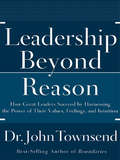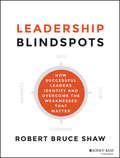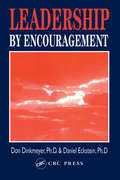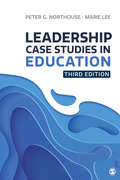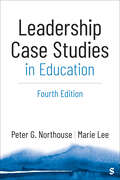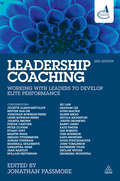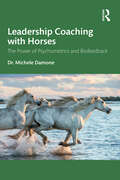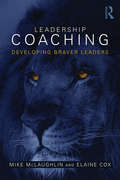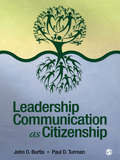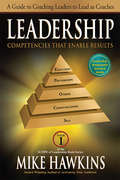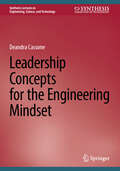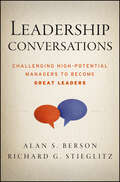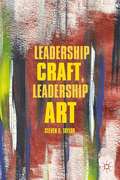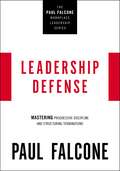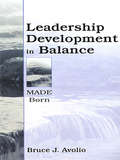- Table View
- List View
Leadership Beyond Reason
by John TownsendA human behavior expert reveals that what leaders know about themselves is more important than their leadership skills and job knowledge. Who we are on the inside can determine leadership success more than what we do or what we know. In Leadership Beyond Reason, Dr. Townsend explores the critical role of the leader's internal world, the world of passion, emotions, intuition, creativity, values, self-awareness, conscience, and spiritual life. Unveiling links between personal and organizational success or failure and the contents of a leader's "heart," the author shows that leaders excel not just through skill and smarts but by connecting with others using competencies, like curiosity, attention, reality assessment, distortion detecting, relationship building, ownership, and living with ambiguity. This is the leadership book only a world-respected psychologist could have written, and it is revolutionary in its insight.
Leadership Blindspots
by Robert B. ShawGood leaders become great by skillfully managing their own vulnerabilitiesLeadership Blindspots: How Successful Leaders Identify and Overcome the Weaknesses That Matter is a comprehensive guide to recognizing and acting on the weak points that can impair effectiveness, diminish results, and harm a career. Written by a 30-year veteran of the leadership consulting industry and author of Trust in the Balance, the book contains examples, worksheets and surveys that illustrate the practical application of the advice presented. An online questionnaire helps readers discover their own leadership vulnerabilities, and the book provides a roadmap for creating a targeted plan to increase their awareness in the areas that truly matter.The blindspot risk is that leaders fail to respond to weaknesses or threats due to a variety of factors including the complexity of their organizations, over-confidence in their own capabilities, and being surrounded by deferential subordinates. Leadership Blindspots provides a useful model for understanding how blindspots operate and why they persist, but at the same time suggests real, actionable steps to improvement. The book details a range of techniques that make blindspots stand out in sharp relief, so action can be taken before severe damage occurs - to a leader or his or her company. Topics include:A framework to understand the threats posed by blindspotsThe four most important types of blindspots - self, team, company and marketsDetailed case studies of blindspots in leaders across a variety of industriesA summary of the most common leadership blindspotsCorrective practices that help mitigate the risks that blindspots poseThe one characteristic great leaders share is the constant desire for self-improvement. Good can always be better. These weaknesses and threats are called blindspots because they are invisible to the individual but have the potential to wreak havoc on one's reputation and long-term success. Identifying and fixing crucial problems is the leader's job, and sometimes the most debilitating problems are with the leaders themselves. Leadership Blindspots: How Successful Leaders Identify and Overcome the Weaknesses That Matter is the first step toward owning and addressing one's vulnerabilities and, as a result, becoming a more effective leader.
Leadership Branding
by Christina GrubendorferDie Kraft einer Marke kommt immer von innen. Deshalb kann eine Marke nicht stark werden ohne Führungskräfte und Mitarbeiter, die die Marke leben. In markenspezifischer Führung stecken beträchtliche, aber meist ungenutzte Produktivitätsreserven eines Unternehmens. Dieses Buch führt den Leser Schritt für Schritt durch einen Leadership-Branding-Prozess und zeigt, wie Markenstrategie, Organisationsentwicklung, Führungsverständnis, Unternehmensstrategie und systemisches Management durch die Verschmelzung in Leadership Branding konkret anwendbar werden. Das Buch gibt Einblick in ein topaktuelles Thema, vermittelt Pionierwissen und macht deutlich, wie Führung produktiv wird. "Authentische glaubhafte Marken entstehen nur, wenn Markenwerte und internes Führungsverständnis im Einklang sind. Dieses Buch ist eine aufschlussreiche und lehrreiche Lektüre für alle, die Einfluss auf Markenführung, Unternehmensführung und Mitarbeiterführung haben." Andreas Ronken, Geschäftsführer Ritter-Sport, Alfred Ritter GmbH & Co. KG "Die Verantwortung der Marke liegt heutzutage bei jedem einzelnen Mitarbeiter. Christina Grubendorfer greift mit Ihrem Buch ein Thema unserer Zeit auf: Ein markenspezifisches Führungsverständnis ist der Schlüssel für einen langfristigen Unternehmenserfolg!" Jens Monsees, Industry Leader, Consumer Goods & Healthcare, Google Germany GmbH "Strategie für die Zukunft: Steigern Sie Ihren Erfolg, lassen Sie Mitarbeiter die Werte Ihrer Marke endlich mit Leben füllen. Dieses Buch sagt Ihnen, wie es geht." Axel Gloger, Wirtschaftsjournalist
Leadership By Encouragement
by Don DinkmeyerLeaders expecting to survive the challenges and associated stress of building their own skill levels have a new tool at their disposal. Leadership by Encouragement is a unique and powerful psychology that will enable you to build an "encouragematic" atmosphere while training leaders to lead.Written by two of the most experienced writers in the
Leadership Can Be Learned: Clarity, Connection, and Results
by Gilmore CrosbyLeadership is poorly understood because human systems are poorly understood. Like the "flat earth" theory of old, modern work culture is limited by a paradigm in which problems are understood as "clashes of personality,"' and blame is directed at the superficial level of individuals, groups, and structure. Leadership Can Be Learned: Clarity, Connection, and Results charts the course to a new paradigm of leadership and systems and how to leverage the relationship between the two. Leadership can be learned because it is a combination of art and science. Ultimately, high- performance culture and high-performance leadership mirror each other, and leaders must use their own unique strengths to foster both. Gilmore Crosby guides the reader by breaking the topic into four powerful sections. The first focuses on the transformational leadership model of Dr. Edwin Freidman, the second describes the systems theory from which that leadership model emerged, the third offers a unique exploration of emotional intelligence and critical interpersonal skills related to leadership, and the fourth and final section applies all the previous sections to attaining organizational results. This book: Delivers a clear how-to guide for leading organizations to higher performance Helps each reader understand, respect, and rise above their own authority issues Conveys a proven approach to life-long self-development so readers can continue to mature in a more objective, non-defensive, and intentional manner. In addition, it provides the skills and framework for applying this approach to effectively coaching and developing others Describes how leaders can be more effective in their interpersonal, group, and large-system interactions Teaches the approach through an engaging mix of historical examples, lessons learned through the author’s experience, quizzes, and metaphors. Provides a solid foundation for leadership development programs With this book, readers will gain a new understanding of themselves and of human systems and learn how, in the words of Gandhi, to "be the change they wish to see in the world" so they and their colleagues can attain and sustain world-class results.
Leadership Can Be Learned: Teaching Adaptive Leadership
by Sharon D. ParksHow well does the case-in-point approach teach the art of adaptive leadership on behalf of the common good in today's world? This chapter examines the central strengths of this approach, its limitations, and the questions that remain for further inquiry.
Leadership Can Be Taught
by Sharon Daloz ParksIf leaders are made, not born, what is the best way to teach the skills they need to be effective? Today's complex times require a new kind of leadership--one that encompasses a mind-set and capabilities that can't necessarily be taught by conventional methods. In this unique leadership book, Sharon Daloz Parks invites readers to step into the classroom of Harvard leadership virtuoso Ronald Heifetz and his colleagues to understand this dynamic type of leadership and experience a corresponding mode of learning called "case in point." Unlike traditional teaching approaches that analyze the experiences of past leaders, case in point uses individuals' own experiences--and the classroom environment itself--as a crucible for learning. This bold approach enables emerging leaders to work actively through the complex demands of today's workplace and build their skills as they discover theory in practice. Through an engaging, you-are-there writing style, Parks outlines essential features of this approach that can be applied across a range of settings. In the process, Leadership Can Be Taught reveals how we can learn, practice, and teach the art of leadership in more skilled, effective, and inspired forms. Sharon Daloz Parks is director of leadership for the New Commons--an initiative of the Whidbey Institute in Clinton, WA. She has held faculty and research positions at the Harvard Divinity School, Harvard Business School, and the Kennedy School of Government at Harvard University.
Leadership Case Studies in Education
by Peter G. Northouse Marie E. LeeLeadership Case Studies in Education 3rd Edition by Peter G. Northouse and Marie Lee applies leadership theories in educational settings. Designed to be used alongside Leadership: Theory and Practice 9th Edition, this casebook provides relevant, substantive, and contemporary case studies on leadership issues in Higher Education and K-12 Education. Each of the 32 case studies include critical thinking questions that encourage students to apply leadership theory and concepts to real-life situations. Engaging, practical, and relevant, Leadership Case Studies in Education is the perfect companion for educational leadership courses.
Leadership Case Studies in Education
by Peter G. Northouse Marie E. LeeLeadership Case Studies in Education 3rd Edition by Peter G. Northouse and Marie Lee applies leadership theories in educational settings. Designed to be used alongside Leadership: Theory and Practice 9th Edition, this casebook provides relevant, substantive, and contemporary case studies on leadership issues in Higher Education and K-12 Education. Each of the 32 case studies include critical thinking questions that encourage students to apply leadership theory and concepts to real-life situations. Engaging, practical, and relevant, Leadership Case Studies in Education is the perfect companion for educational leadership courses.
Leadership Case Studies in Education
by Peter G. Northouse Marie E. LeeLeadership Case Studies in Education 4th Edition by Peter G. Northouse and Marie Lee applies leadership theories in educational settings. Designed to be used alongside Leadership: Theory and Practice 10th Edition, this casebook provides relevant, substantive, and contemporary case studies on leadership issues in Higher Education and K-12 Education. Each of the 32 case studies include critical thinking questions that encourage students to apply leadership theory and concepts to real-life situations. Engaging, practical, and relevant, Leadership Case Studies in Education is the perfect companion for educational leadership courses. New cases explore social identity leadership and team leadership theories, with examples including the challenges of teaching virtually during the COVID-19 pandemic, the formation of a union of college adjunct professors, and a high school′s challenge in changing their offensive school mascot symbol.
Leadership Case Studies in Education
by Peter G. Northouse Marie E. LeeLeadership Case Studies in Education 4th Edition by Peter G. Northouse and Marie Lee applies leadership theories in educational settings. Designed to be used alongside Leadership: Theory and Practice 10th Edition, this casebook provides relevant, substantive, and contemporary case studies on leadership issues in Higher Education and K-12 Education. Each of the 32 case studies include critical thinking questions that encourage students to apply leadership theory and concepts to real-life situations. Engaging, practical, and relevant, Leadership Case Studies in Education is the perfect companion for educational leadership courses. New cases explore social identity leadership and team leadership theories, with examples including the challenges of teaching virtually during the COVID-19 pandemic, the formation of a union of college adjunct professors, and a high school′s challenge in changing their offensive school mascot symbol.
Leadership Coaching
by Jonathan Passmore Association for CoachingThis revised edition of the highly-respected Leadership Coaching will enhance and extend your coaching practice. It draws on evidence-based thinking and the writing of some of the world's top leadership thinkers and coaching practitioners to present a start-of-the-art coverage of leadership models and how to use them effectively to benefit your coaching relationships. Leaders face many challenges, and this book will challenge you to adapt your coaching approach to suit your clients' needs. Its coverage ranges from newer topics such as strengths focused leadership and conversational leadership to more tried-and-tested frameworks such as Porter's strategy model and Goleman's model of leadership styles. It also has a deliberately international flavour, incorporating non-Western perspectives from Asia and Africa and considering multinational topics like coaching global boards.
Leadership Coaching with Horses: The Power of Psychometrics and Biofeedback
by Michele DamoneLeadership Coaching with Horses offers a transformative approach to leadership development, combining the intuitive power of equine-assisted learning with the precision of biometric technology and psychometric profiling.This book introduces a pioneering method that harnesses the unique sensitivities of horses alongside advanced biofeedback mechanisms like heart-rate variability (HRV), providing a comprehensive pathway to enhance personal and professional growth. Delving into the synergistic relationship between humans and horses, this guide details how such interactions foster heightened self-awareness and emotional intelligence. It presents a structured framework for leadership sessions that merge feedback from horses with robust data from biometric and psychometric assessments, enabling a detailed exploration of leadership traits and behaviours and offering measurable outcomes for development.Distinguished by its novel integration of biometrics and psychometrics into leadership coaching with horses, this book is designed to deepen understanding and enable leaders to make real-time, impactful enhancements to their leadership styles. With practical applications, case studies, and a clear articulation of benefits, it is an essential resource for coaches, HR professionals, and leaders seeking innovative, evidence-based tools for advancement.
Leadership Coaching: Developing braver leaders
by Elaine Cox Mike McLaughlinLeadership Coaching offers a new model of coaching for leadership development. It explains how the brave model extends existing leadership theories, and includes specific coaching processes and sense-making techniques to allow the reader to understand how the model would work in practice. The book begins by asking why it is important for leaders to be brave. It provides an overview of existing leadership theories, and their limitations, as well as introducing the brave coaching approach and the elements that comprise the model. The book includes practical case studies that provide insights into the range of applications for the brave leadership coaching framework. Based on academic research, and written in an accessible scholarly style, this book shows how coaching can assist in decision making, leading to a different, braver form of personal and corporate leadership. It should be of interest to students of management, leadership, coaching and mentoring, as well as professional coaches and leaders.
Leadership Communication as Citizenship
by John O. Burtis Paul David TurmanLeadership Communication as Citizenship explains the communication skills you need to help construct effective experiences for an organization, team, or community, whether in the role of doer, follower, guide, manager, or leader. It articulates the important role that communication plays in helping to co-construct group, organizational, or community direction. Effective leadership communication is explored in the context of citizenship, emphasizing the opportunities and responsibilities we each face for helping groups that matter to us, whether a business, a religious institution, or a government entity.Throughout the book, authors John O. Burtis and Paul D. Turman relay a compelling, readable story about how to create more successful organizations and communities through direction-giving stories, regardless of one′s role in the group.Key FeaturesExplains the daily interplay between communication, citizenship, and direction-giving, thus challenging readers to realize the power they have to give direction in their own team, organization, or communityFocuses on common communication skills involved across seemingly disparate leadership contexts—from working in teams to communities to social movements or elsewhere—to help people succeed in the setting in which they find themselvesExplores times of crisis and use of leadership vision, discussing how direction-giving approaches may require adjustment in these times of extreme opportunity, threat, or change.Intended Audience: Leadership Communication as Citizenship is appropriate for anyone who wants to make a difference in their team, organization, or community, and for such courses as Leadership, Organizational and Group Communication, Industrial/ Organizational Psychology, Persuasion, and Management.
Leadership Competencies that Enable Results: A Guide To Coaching Leaders To Lead As Coaches (book 1 Scope Of Leadership) (SCOPE of Leadership Book Series #1)
by Mike HawkinsFirst in the “most comprehensive treatment of leadership I’ve ever seen by one author . . . full of insightful assessments, useful tools, and practical tips” (Jim Kouzes, coauthor of The Leadership Challenge).Leadership Competencies That Enable Results explores the essentials of great leadership and establishes the principles that underpin the ability to coach, lead, and achieve high levels of organizational performance. Laying the groundwork for the competencies introduced over the course of the series, this book guides you in building a leadership roadmap for yourself and others to follow on the journey to enabling great results.The SCOPE of Leadership book series teaches the principles of a coaching approach to leadership and how to achieve exceptional results by working through people. You will learn a straightforward framework to guide you in developing, enabling, exhorting, inspiring, managing, and assimilating people. Benefit from the wisdom of many years of leadership, consulting, and executive coaching experience. Discover how to develop the competencies that align consistently with great leadership.“Hawkins clearly and succinctly presents the difference between being a manager and a true leader . . . Anyone who wants to be a modern-day effective leader will have much to gain by reading this first book in the SCOPE of Leadership Book Series.” —Foreword Reviews
Leadership Concepts for the Engineering Mindset (Synthesis Lectures on Engineering, Science, and Technology)
by Deandra CassoneThe book is intended to focus the engineer or technically minded individual on key aspects of their organization and how they can leverage their position to make a positive impact. The author explains why it is critical that the technically minded individual is aware of their corporate environment and how they and their organization fit within the organizational structure. Technical knowledge is just one component of success for engineers. The book provides readers with the tools to understand where they fit in with their organizations and what they can do to support corporate objectives. This book will address topics including gaining a big picture of an organization, defining what a specific organization does, understanding goals and objectives to align management strategies, budgeting, role in the supply chain, engineering career paths, and the importance of innovation.
Leadership Conversations: Challenging High Potential Managers to Become Great Leaders
by Alan S. Berson Richard G. StieglitzConversation techniques and tools that can help strong managers become great leaders Often the very same skills and traits that enable rising stars to achieve success "tenacity, aggressiveness, self-confidence" become liabilities when promoted into a leadership track. While managers' conversations are generally transactional and centered on the task at hand, leaders must focus on people, asking great questions and aligning them with the vision for the future. Leadership mindsets and skills can be developed, and Leadership Conversations provides practical guidance for connecting with others in ways that transform each interaction into an opportunity for organizational and personal growth. Identifies four types of conversation every leader must master: building relationships, making decisions, taking action, and developing others Provides an action plan for boosting your personal leadership potential, as well for developing leadership skills in others Draws on the authors' rich experience coaching and working with leaders at a wide range of organizations, including NASA, the U.S. Navy, intelligence agencies, Boeing, Gillette, Bausch & Lomb, and Georgetown University Leadership Conversations is required reading for both high-potential managers looking to make it to the next level and leaders looking to develop their people.
Leadership Craft, Leadership Art
by Steven S. TaylorTaylor leads readers through creativity and how it relates to leadership followed by the five stages of theory behind the idea: 1) preparation, 2) time-off (or incubation), 3) the spark, 4) selection, and 5) elaboration.
Leadership Defense: Mastering Progressive Discipline and Structuring Terminations (The Paul Falcone Workplace Leadership Series)
by Paul FalconeGreatly reduce the stress of managing a team with this quick and reliable information on how to correctly master—both legally and ethically—progressive discipline and structured termination, from the leading voice in HR expertise.This resource takes the highly complicated subjects of progressive employee discipline and structured terminations—actions that can be rife with legal issues and paperwork—and breaks down the process for HR professionals and managers to easy-to-understand steps.Chock full of wisdom from Paul Falcone, a renowned expert on labor & employment law and business decision-making and problem-solving, this book answers questions ranging from basic to sophisticated, including:Why should I conduct an exit interview?How do I protect my company from negligent hiring claims?How do I terminate a long-term employee with a history of positive performance evaluations?And much, much more.Each question is followed by an easy-to-implement solution, making this book perfect both as a concise overview and as a practical reference.
Leadership Development Interventions: Ensuring a Return on the Investment
by Jay A. CongerLeadership development initiatives can and should play a critical role in building the bench strength of leadership talent in an organization. At the very least, these programs can heighten managers' appreciation of good leadership; at the most, they can facilitate a common and widespread understanding of the organization's vision and culture, integrate training with job promotions, and build champions to implement critical strategies. This chapter explores how formal leadership training programs can best be deployed to achieve these kinds of impact. It examines a range of approaches and the trade-offs unique to each, with a closer look at the practices that enhance a program's effectiveness, as well as some common pitfalls. In short, successful leadership development programs must be well designed, tightly aligned to the organization's strategy, and supported by its performance management systems. This chapter was originally published as Chapter 24 of "Handbook of Leadership Theory and Practice: A Harvard Business School Centennial Colloquium."
Leadership Development at Goldman Sachs
by David Lane Boris Groysberg Scott A. SnookIn November 1999, 11 of Goldman Sachs' finest gathered to put the final touches on a revolutionary leadership development plan. Following Goldman's explosive growth during the 1990s and its eventual IPO in 1999, a diverse group of leaders from across the firm were selected to "assess the future training and development needs of Goldman Sachs, with a particular focus on the need for a more systematic and effective approach to developing managing directors." After six months of brainstorming, holding discussions with Goldman Sachs colleagues, interviewing experts, and benchmarking best practices, it was finally time to present their findings to the management committee. The briefing contained an integrated leader development plan with concrete recommendations on how to resolve several critical design issues, including: location, faculty, content, format, method, target audience, governance, and sponsorship. No one sitting on the management committee had relied on a formal leadership program to reach the top. How skeptical might they be? How do you convince hard-nosed bankers to leave their desks and invest precious time focusing on what many perceived as "soft" issues?
Leadership Development for Interprofessional Education and Collaborative Practice
by Marion Jones Jill Thistlethwaite Dawn FormanLeadership Development of Interprofessional Education and Collaborative Practice is an edited compilation of chapters written by international medical and health professional experts. The book provides historical and current perspectives on leadership in healthcare.
Leadership Development in Balance: MADE/Born
by Bruce J. AvolioThis book, written by a leading scholar in leadership, takes readers through a very realistic look at what it takes to develop leadership competencies. Focusing on four major goals, this text:*provides the reader with a broader and deeper understanding of what constitutes authentic leadership development;*challenges a very basic notion that leaders are born versus made;*talks about the elements that comprise leadership development so readers are informed to ask the many providers of leadership development the right questions; and*develops full leadership potential.There are numerous case examples used throughout the book: high-tech executives, community leaders, correctional service supervisors, bank managers in Canada, and platoon commanders in Israel. Each example is used as a general basis for discussing how people develop their leadership potential, and as models of training and evaluation.Leadership Development in Balance: MADE/Born is intended for graduate or undergraduate students of leadership, project managers, supervisors, senior executives, school principles, health care officers, or legislators.
Leadership Development in Emerging Market Economies
by Alexandre Ardichvili Khalil DiraniThis edited volume focuses on leadership development in emerging economies in the BRICS, CIVETS and other developing countries. Chapter authors offer a unique view of indigenous practices and perspectives from HRD, HRM, and management and leadership studies.
